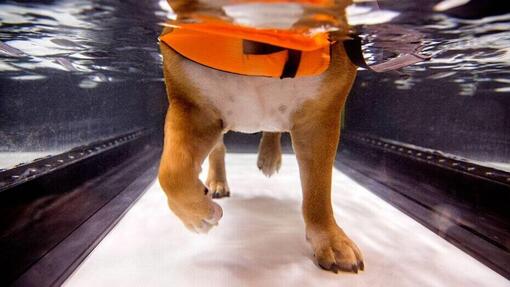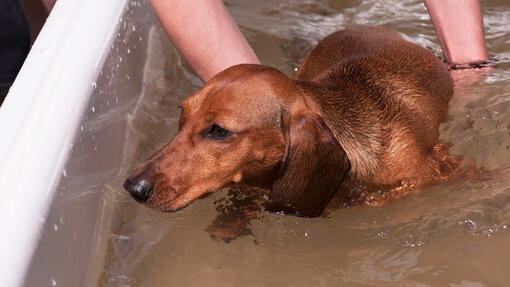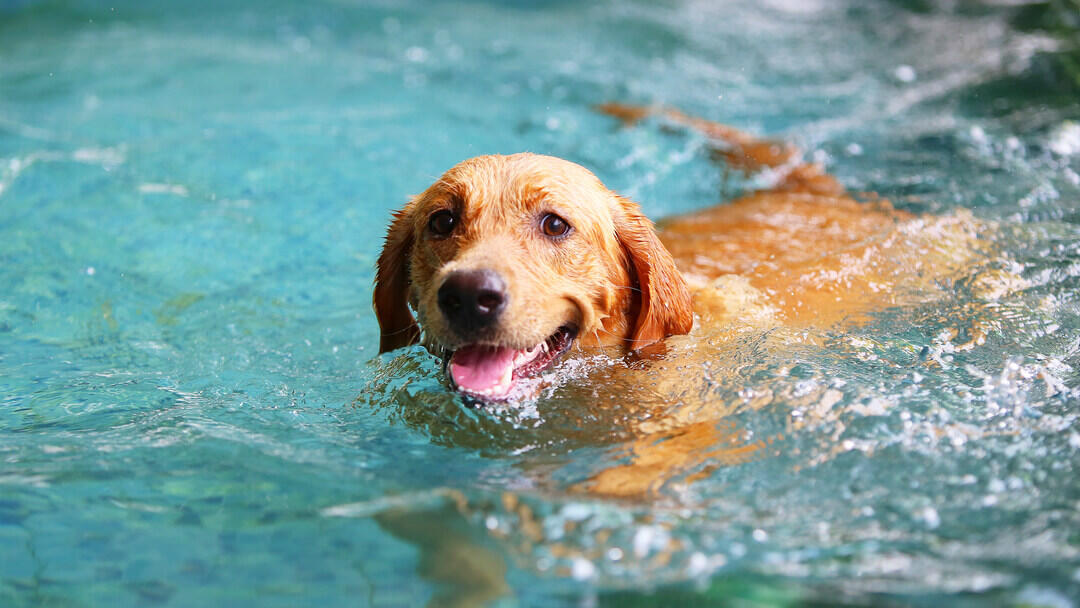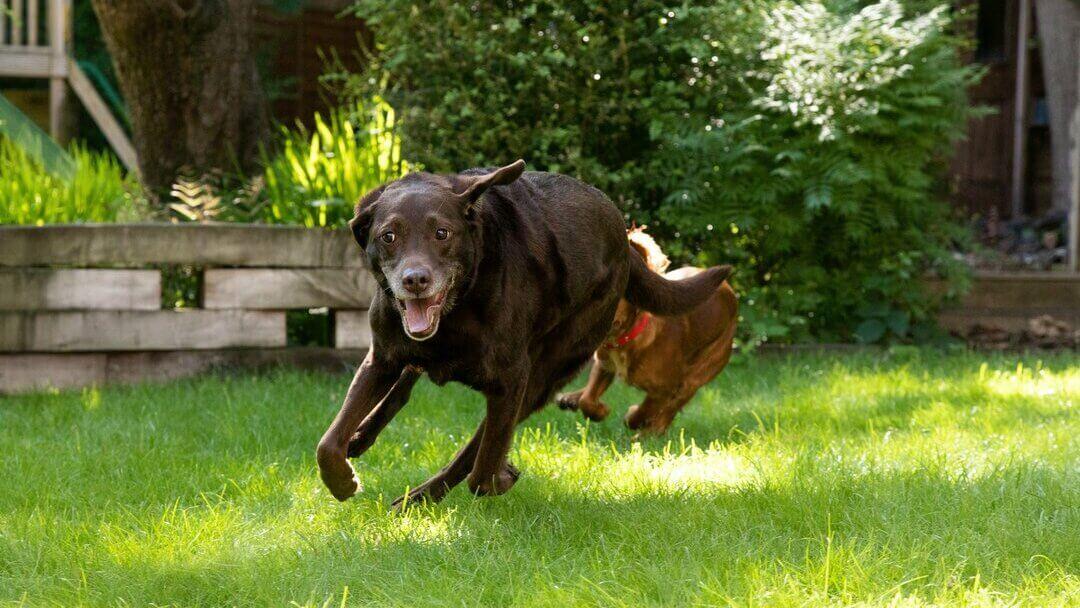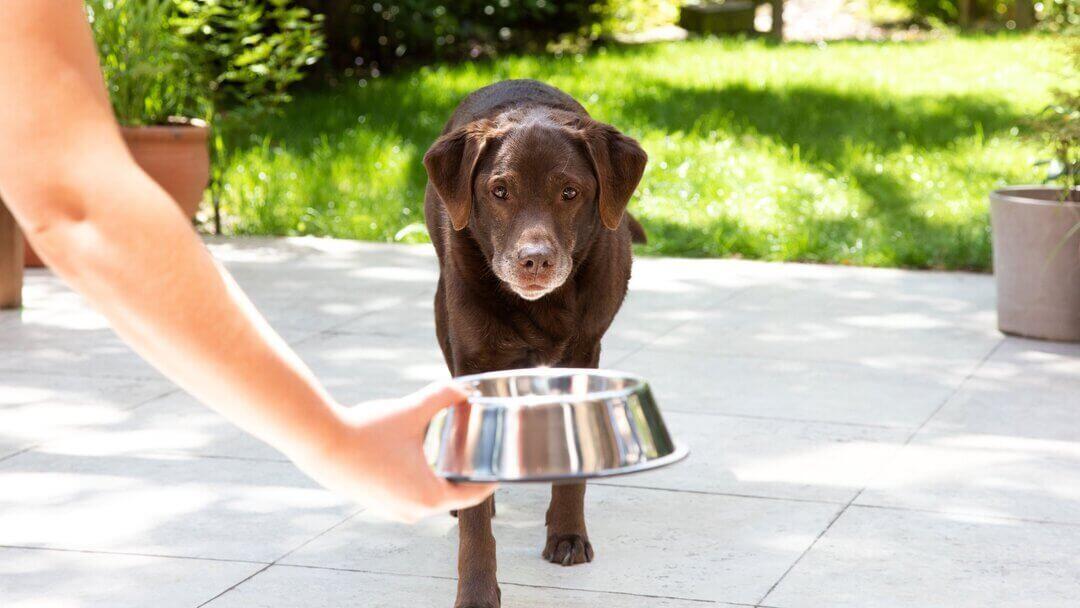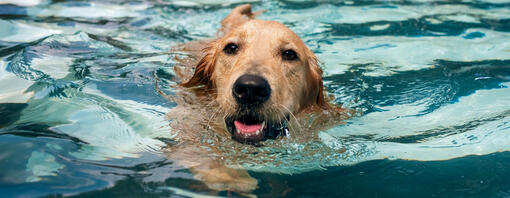
Does your dog love splashing in every puddle they can find? You might be thinking your pet has already discovered canine hydrotherapy by themselves, but this form of therapeutic exercise is much more than just playing in water. If you’re wondering what hydrotherapy for dogs is, and whether your dog can benefit from it, keep reading to discover more about this increasingly popular form of physical therapy.
What is canine hydrotherapy?
Hydrotherapy for dogs uses water to facilitate rehabilitation of pets suffering from various conditions or injuries, particularly for joint conditions or to help build up muscle again after surgery. Water helps to support a dog’s weight so that they can start the road to recovery with lower-impact movements that are not too taxing on their joints. Sometimes these exercises will be targeted to help treat a particular body-part, and other exercises might aim to increase general fitness and wellbeing.
There are different types of canine hydrotherapy, so before you book your dog’s first session, it’s important to make sure your pet is getting the best treatment for their condition by discussing the available options with your vet.
Types of hydrotherapy for dogs
Hydrotherapy can be a great idea, especially for a pooch that loves water, but there are a few different versions of therapeutic exercises to choose from. Here are the different types of water-based exercises that can help to improve various health condition in dogs. Your veterinary team will be able to advise which type of hydrotherapy will best suit your pet, depending on the goals of the therapy and any underlying conditions.
Underwater treadmills
A specialised treadmill in a water tank is commonly used for hydrotherapy. This will have see-through walls so that the veterinary hydrotherapist can observe their patient from different angles, although they may also spend time in the tank with the dog too. The dog’s head is above the water at all times, with the water generally filled up to a level that covers the dog’s legs. The veterinary hydrotherapist will help the dog with a series of exercises and the water will help to support the dog’s weight, meaning they can exercise in a low-impact environment, which has a wide range of benefits including increasing fitness, mobilising joints and building up muscle strength.
Dog pools
Dog pools offer another popular type of canine hydrotherapy. A key difference between this and the treadmill is that the dog will essentially be swimming. While the water in the pool helps to support the dog, they may also need additional buoyancy aids and will be accompanied in the pool by a hydrotherapist. This type of therapy can be particularly useful for targeting different areas including shoulders, elbows or legs to improve muscle and joint strength.
Whirlpool therapy
Water jets are used to massage the affected muscles or joints and help alleviate the pain. This is essentially a type of manual therapy, similar to massage or acupuncture, but it may be less targeted. Whirlpool therapy is sometimes used to help with pain management, but the other forms of hydrotherapy mentioned above are more common for building up muscle strength and mobilising joints.
What are the benefits of hydrotherapy for dogs?
Hydrotherapy is used to aid recovery from many different health issues and it can also be a great way to get a dog used to water and help them build stronger muscles. Here are some of the ways hydrotherapy may benefit your pet:
- Helps increase balance and coordination
- Rebuilds muscle mass
- Increases blood circulation
- Helps to relieve pain
- Aids digestion
- Helps with recovery after surgery
- Helps to reduce inflammation
- Improves stamina
- Helps with weight loss
What conditions can be treated using hydrotherapy for dogs?
If your dog is suffering from one of the following conditions, it’s worth talking about canine hydrotherapy with your vet, as this may be appropriate as part of a multimodal treatment plan:
- Hip dysplasia
- Arthritis
- Weight problems
- Neurological conditions
- Anterior cruciate ligament injuries
Is hydrotherapy safe for dogs?
Canine hydrotherapy is a process carried out by professional therapists trained to make sure the experience is as safe and as comfortable as possible for your pet. Special equipment such as life vests and harnesses are used depending on the type of hydrotherapy and your pet should be monitored at all times during the session.
However, dogs suffering from ear infections might not be suitable for hydrotherapy due to the possibility of water getting inside their ear and making the condition worse. And, whether your dog suffers from ear conditions or not, it’s always a good idea to check with the vet to make sure canine hydrotherapy is likely to be the right option for your pet.
How to choose the right place for canine hydrotherapy
If you’ve got the go-ahead from the vet, it’s time to look for the best hydrotherapy service for your dog. Most veterinary practices will be able to refer you to a veterinary centre that provides hydrotherapy and other rehabilitation services. One of the most important things to check is that the therapists are licenced professionals. You can also look for reviews from other dog owners and see how satisfied they were with the service. Or you could even book a visit to talk with one of the therapists. They should be happy to answer all your questions and might even let you watch one of their hydrotherapy sessions to see what’s in store for your pup.
Should you try dog hydrotherapy at home?
Pet owners with quick access to a body of water close to home or a pool in their back yard might be tempted to try hydrotherapy at home. However, owners should never try home hydrotherapy treatment as it is essential for this to be carried out under special supervision by a licensed professional to avoid making any illnesses or injuries worse. Canine hydrotherapy should take place in a well-controlled environment and should only ever be carried out by a licensed professional, so that everything from the water level and temperature to the type of exercise is carefully chosen to achieve the maximum benefits based on your dog’s needs. Incorrect exercise could place strain on your pet’s body and lead to further problems.
What to do if your dog is scared of water?
Hydrotherapy for dogs can be extremely beneficial, but sometimes water can make pets quite anxious. Dogs will need to be used to getting into water to go to hydrotherapy. If your dog doesn’t like water, you should take steps to help them feel more comfortable before their first hydrotherapy session and it’s a good idea to discuss this with your hydrotherapist ahead of time to ensure that your water training is safe for your pet given their condition.
A kiddie pool can be a good investment for pet owners with dogs scared of water. The shallow water is a good first step to get their paws wet and start getting them accustomed to being submerged. Don’t forget to keep calm and offer your pet treats or toys and positive reinforcement where appropriate. The more gradual the process, the easier it will be for your dog to get comfortable with water. Always make sure you allow your dog to enter the water voluntarily at their own pace. Don’t hesitate to look for professional help if you think your dog is too anxious and can’t get over their fear.
Next, learn how to deal with fear and anxiety in dogs and take time to understand your dog’s personality to help them get through those challenging moments easier.



